|
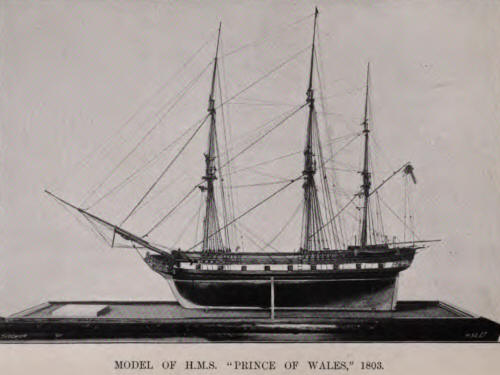
THE work for the Navy by the Scotts began with the building, in 1803, of a
sloop-of-war named The Prince of Wales; a photograph from the model of
this vessel is reproduced on Plate XIV.
Since the construction of this ship the firm have carried out several
important Admiralty contracts, including the first machinery manufactured
in Scotland for a dockyard-built ship, the first steam frigate built in
the North, and several later ships, with their engines; the most recent
order being for the machinery of the armoured cruiser Defence, of 14,600
tons displacement, and 27,000 indicated horse-power, to give a speed of 23
knots.
The progress demonstrated by a contrast between the small sloop-of-war and
this latest powerfully-armed and well-protected high-speed cruiser, is a
record of research and invention, not only on the part of the naval
architect, but also of the chemist, the metallurgist, and the engineer;
the triumph is greater than that reviewed in the case of the Merchant
Marine. Great speed has been achieved, notwithstanding that the problems
to be solved in its attainment have been intensified by the limitations in
the size of the ship in order to minimise the target presented to the
enemy's fire, and by the necessity of providing for heavy armour,
armament, and ammunition in the displacement weight.
When a comparison is made of the Navy ships at the beginning of the
nineteenth century with those of a hundred years earlier, it is found that
little progress had been made, either in design or in gun-power. The
largest vessel in 1700 was of 1809 tons burden, with a hundred guns. A
century later, the size had increased only to 2600 tons, with a hundred
and twenty guns.' But even this was an exceptionally large vessel. The
British ships were, as a rule, smaller, and perhaps slower, than the
French ships; but then—as now and always—skill in strategy, courage in
combat, and devotion to duty were the most powerful factors in action. No
fault in these respects could be found with the work of our Navy in the
various engagements which terminated in the epoch-marking victory in
Trafalgar Bay.
The peace following the Napoleonic wars was not conducive to advancement,
as there was little incentive to pursue the sciences which contributed to
the development of destructive weapons. Steam as a motive power and iron
as a constructive material were not so readily adopted in the Navy ship as
in the Merchant Marine. Progress in the utilisation of iron was not
continuous. The first application of steam was belated, and its popularity
was not unalloyed.
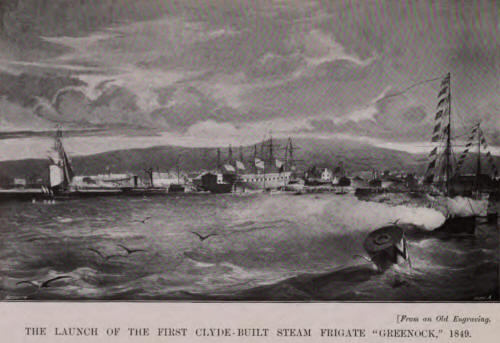
The Admiralty ordered their first ship of iron in 1839—a small,
non-fighting boat for the Dover station— and there followed other vessels
for the exploration of the River Niger. But the first iron fighting ship
was not built until 1843. In 1848-9 the Scotts constructed the iron steam
frigate Greenock, the largest iron warship of her day, and the first steam
frigate built on the Clyde. The over-all length of this vessel was 213
ft., the beam 37 ft. 4 in., and the depth of hold 23 ft. She was of 1413
tons burden, and carried ten 32-pounder smoothbore muzzle-loading guns.
The illustration on Plate XV. is a reproduction from an old engraving of
the launch of the vessel. It is a noteworthy feature that the figure-head
was a bust of John Scott, the second of that name. This compliment by the
Naval authorities of the time was well merited, as he did much not only
for the advance of naval architecture, but also for the development of
Greenock.
As a writer of the day put it, this vessel was the experimentum crucis of
the principle of constructing fighting ships of iron.' By 1850 there were
six large iron vessels, ranging downwards from the 1980 tons of the
eighteen-gun ship Simoon, with eleven smaller vessels; but they were all
condemned, because it was found by experiment' that the 32-pounder gun at
short range could perforate the side of the iron ship, and that the
projectile carried its "cloud of langrage" with great velocity into the
interior of the ship, so that men could not stand against it. Tests were
also made with sixteen wrought- iron plates superposed, to give a total
thickness of 6 in., but these also were perforated by the 32-pounder
projectiles at 400 yards range; so that the adoption of iron on the main
structure of the ship was practically delayed until armour-plates were
first rolled in 1859.
The obstacle to the adoption of steam was the unsuitability of
paddle-wheel machinery for fighting ships. The wheel was exposed to
gun-fire, and the whole of the machinery could not be located below the
water line. Moreover, the side wheel limited the number of guns which
could be utilised for broadside fire. The first steam craft ordered by the
Admiralty was a small vessel of 210 tons and 80 nominal horse - power,
built in London in 1820.1 Several other non-fighting steamships followed.
By 1837, the largest steam vessel in the fleet was a sloop of 1111 tons
and 320 horse-power.' In 1839 five steam vessels were built, and two of
them—the Hecate and Heckiwere engined by the Scotte. These wooden steamers
were the first Naval vessels sent to Scotland to have their machinery
fitted on board. They were of 817 tons and 250 horse-power. The
paddle-wheels had a diameter of 25 ft. 4 in., and there were seventeen
floats. The main engines, illustrated on page 29, represent the type
adopted, not only in the Naval, but in the Merchant service of this time.
The steam pressure was then about 3 lb. per square inch.
On Plate XVI. we illustrate the general arrangement of the machinery in
the Hecate and Hecla. There were four boilers of the rectangular type,
each with two wet- bottomed furnaces at one end and large return flues at
the other end. The uptakes passed up inside the boilers through the steam
space, uniting in one funnel.
Smith's screw-propeller was tried experimentally in 1837, and Ericsson's
about the same time. The comparative trials of the Archimedes fitted with
Smith's screw against existing paddle - steamers did much to prove the
efficiency of the new system.8 The screw-ship excelled the performance of
paddle-steamers on the service, and the screw-propeller was adopted by the
Admiralty in 1845 twin-screws followed twenty-five years later.
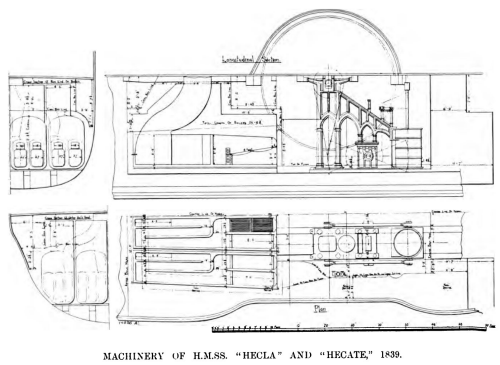
The Greenock, built in 1848, was the first war vessel by the Scotts fitted
with the screw-propeller. We have already referred to her construction in
iron, and to her launch. She had a displacement of 1835 tons, and her
engines were of 719 indicated horse-power. The speed realised on the trial
was 9.6 knots. The Greenock's machinery, which is illustrated on the next
page, is specially interesting, as it represents one of the earliest
attempts to drive the screw-propeller by gearing. Two horizontal cylinders
were fitted, each 71 in. in diameter, with a stroke of piston of 4 ft. The
gearing consisted of four sets of massive spur-wheels and pinions, in the
ratio of 2.35 to 1, so that 42 revolutions per minute of the engines give
98.7 revolutions to the propeller- shaft. The propeller was 14 ft. in
diameter, and was so fitted that it could be detached and raised to the
deck. There were four rectangular brass-tube boilers, each with four
wet-bottomed furnaces, and all the internal uptakes united in one funnel,
which was telescopic, so that when it was lowered and the propeller raised
out of the water, the vessel had the appearance, as well as the facility,
of a sailing frigate.
As will be seen from the drawings, both the engines and boilers were
arranged very low in the hull, to be safe from the enemy's fire. The
engine and boiler compartment occupied 72 ft. of the length of the
ship—about one-third of the total length—and the seating for the machinery
was specially constructed, with a very close pitch of frames which were
only 1 ft. apart. For comparison with the drawings of the machinery in the
Greenock, we give on page 49 a similar drawing of the machinery of the
Canopus, of 12,956 tons displacement, seven times that of the Greenock. To
double the speed, the power of machinery had to be multiplied twenty
times, and yet the space occupied is only about trebled.
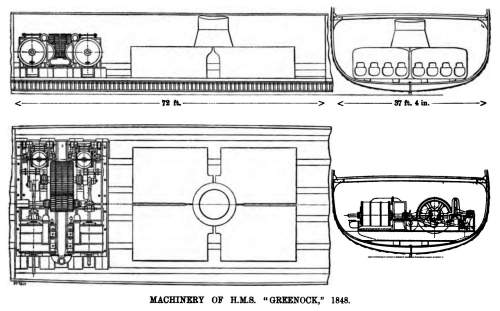
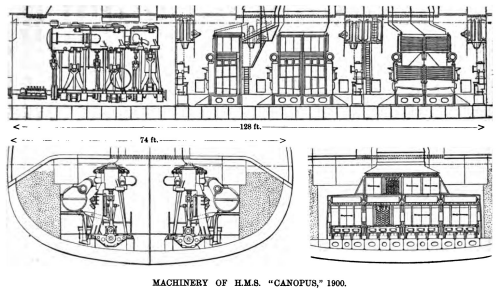
In 1850 the largest of the steam vessels in the Navy' had a displacement
of 3090 tons, but the most noted was the Dauntless, of 2350 tons
displacement, with engines of 1347 indicated horse-power to give a speed
of 10 knots. It is true that there were three smaller vessels of greater
speed, one of 196 tons steaming 11.9 knots; but this was the highest rate
reached in the Navy service. By this time some of the fast mail steamers
made 134 knots. These latter were suited for war service, but we have
already dealt with them.
Following the adoption of the screw-propeller in warships came the
abandonment of gearing for the engines. For many years various forms of
horizontal engine were used; first with return-connecting rods, and
subsequently with direct-acting rods. Steam pressures steadily increased,
largely owing to stronger materials being available. It was, however, not
until the 'seventies that the cylindrical boiler, the compound engine, and
the surface condenser admitted of an increase to 60 lb. per square
inch'—several years after these improvements had been introduced in the
Merchant Marine.
The Scotts had worked steadily at the solution of the problem from their
trials with the Thetis in 1858 (see page 34 ante). In 1860 the late John
Scott, C.B., laid before the Admiralty a system of water-tube boilers and
compound engines, but objection was raised to the system. The French Naval
authorities, with whom the Scotts then had close business connection, took
up the scheme, largely because of the favour with which it was viewed by
M. Dupuy de Lôme, the head of the Department. The first ship fitted was a
corvette of 650 tons displacement; the boilers worked at a pressure of 140
lb., while the initial pressure at the compound three-cylinder engines was
120 lb. These were the first engines of the compound type in the French
Navy.
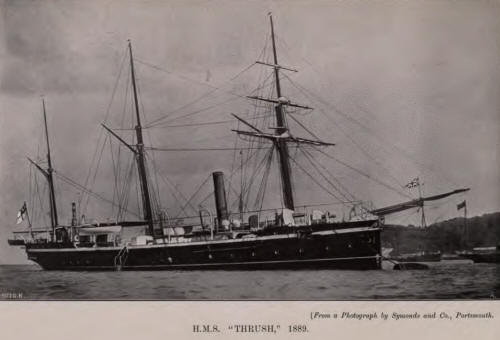
The Scotts were at the time building engines for four corvettes under
construction at the Woolwich and Deptford yards for the British Navy; and
the Admiralty agreed to have fitted in one of them water-tube boilers and
engines similar to those built for the French boats. The boilers may be
said to have belonged to the same general type as the Thornycroft and
Normand water-tube steam generators. It was subsequently found impossible,
however, to ensure that the top of the boilers should be at least 1 ft.
under the load-line—a condition then enforced in steam vessels for the
Navy—and the adoption of the water-tube boiler was deferred, the ordinary
machinery of the period being fitted to work at 25-lb. pressure instead of
120-lb.
This was unfortunate, as it removed the incentive to continued research
needed to make the water-tube boiler a really satisfactory steam
generator. The Scotts, however, continued to work for the successful
application of high pressures, and it was this that brought them into
contact with the late Mr. Samson Fox, with whom they were closely
identified for many years in connection with the development of the
corrugated flue and the cylindrical steam boiler.
Opinion being adverse to the water-tube boiler, notwithstanding its
acceptance by many foreign Navies, there was a strong agitation fostered
by engineers to induce the societies for the registry of shipping, and
also the Board of Trade, to increase the ratio of the working to the test,
pressure in boilers. The British Admiralty allowed the boiler to be worked
up to within 90 lb. of the test pressure, whereas in the Merchant Service
the working pressure was limited to one-half of the test pressure. In 1888
the Scotts, being convinced that the Admiralty system afforded quite a
satisfactory factor of safety, undertook the experiment of submitting a
warship boiler, then being built by them to Admiralty specification, to
the highest possible pressure, even up to bursting-point. The boiler
ultimately leaked to such an extent, after the pressure had been
maintained for a long period at 620 lb. per square inch, that it was not
considered necessary to proceed further. The stresses at this stage worked
out to 48,130 lb. per square inch; and the result proved that there was
some justification for a reduction in the minimum scantlings of the shells
of marine boilers to, at least, the scale adopted by the Admiralty.
These suggestive experiments were carried out in connection with the
boilers constructed in 1888-9 for two war vessels built by the Scotts.
These vessels were the Sparrow and the Thrush. At the same time, the
Scotts engined two other vessels of the same type, constructed at the
Royal Dockyards. A view is given on Plate XVII. of the Thrush, which was
commanded by H.R.H. the Prince of Wales on the North American and West
Indian stations in 1891. She was a vessel of composite build, of 805 tons
displacement, with machinery of 1200 horse-power, to give a speed of 13
knots; but, as is shown by the illustration, she was fitted as a three-masted
schooner, and utilised her sails when the wind was favourable. In this
respect, she marks the transition stage between the days of the sailing
craft and the modern ship, depending entirely on steam for propulsion.
Indication is afl'orded of the progress towards this transformation by
Table III. on the opposite page, which shows the improvement in economy in
the machinery of warships at various stages in their development.
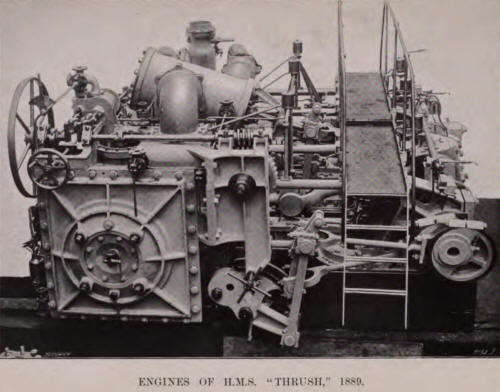
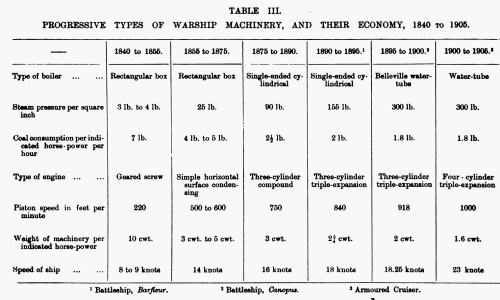
The figures in the Table are average results rather than highest
attainments during the periods. For 1890-95 we have taken the Barfieur,
the engines of which were constructed by the Scotts in 1894; whilst the
particulars for 1895-1900 refer to the Canopus, engined by them in 1900.
In 1902 they also supplied the machinery for the battleship Prince of
Wales, and commenced the construction of the armoured cruiser Argyll. But
before referring in detail to these latter ships, we may briefly review
the advances in applied mechanics, metallurgy and chemistry, which have
contributed largely to the perfection of these modern fighting ships in
respect of offensive and defensive qualities.
The gun most in favour at the close of the eighteenth, and at the opening
of the nineteenth, centuries was the cast-iron, smooth-bored,
muzzle-loader: first the 32-pounder and later the 68-pounder. Carronades
were used for "smashing" rather than for penetrating the skin or structure
of ships. Although the 68-pounders were improved by a lining of wrought
iron being inserted in the bore, whereby the energy at 1000-yards range
was increased from 290 to 600 foot-tons, little progress was made until
after the Crimean War, when chemists undertook the investigation of the
action of explosives and metallurgists sought to produce stronger metals.
The general idea as regards the powder used as a propellant was that the
ignition was instantaneous, and that the more violent the explosion the
greater would be the velocity of the projectile. Under such conditions
short weapons naturally found favour; and indeed, with a light, spherical,
ill-fitting projectile, there was very little advantage to be gained by
lengthening the bore. But with the introduction of rifled cannon, much
heavier and better- fitting shot became possible, and a rapid-burning
powder gave rise to dangerous pressures in the gun. It was then realised
that it was not an explosion that was wanted, but a continuous pressure
acting on the base of a shot for a relatively considerable period. This
needed a slow- burning explosive, and led to the manufacture of powder as
pebbles or prisms; the enlargement in the late 'seventies of the chamber
of the gun, and the provision of air spaces for the expansion of the
powder, greatly added to the velocity with which the shot left the gun,
and therefore augmented its carrying power.
Gun-makers had meanwhile improved the strength of the weapon by a
recognition of the fact that wrought iron was twice as strong in the
direction of the fibre as across it; and thus in the 'sixties they began
to coil the central tube, surrounding it by hoops, welded or shrunk on.
The full advantages of fibre were thus secured for resisting
circumferential strain. The bore was rifled to give the shot that rotatory
motion which prevents irregularity in flight and conduces to accuracy of
fire at long range. The smooth-bore gun was effective up to only 1000
yards range, as compared with the 6000 yards and 7000 yards for the modern
weapon. Breechloading was first introduced into the Navy in the 'sixties,
but discarded because the details for closing the breech end proved
unsatisfactory. Finally, it was reintroduced in 1878, a satisfactory
mechanism having been devised.
These various improvements gradually increased the power of the gun. The
length and weight had enormously grown, as is shown by the particulars of
successive large Naval guns, shown in Table IV. on the next page; but the
increase in energy up till the 'eighties was not commensurate with the
augmentation of the weights of the projectile and charge.
The advance from the 38-ton gun of 1870 to the 110½-ton gun in 1887
involved the multiplying by five of the charge of powder, which quadrupled
the energy of the gun, but the carrying power of the shot was still
deficient. The velocity had increased in twenty years from 1600 to 2000
ft. per second, slower-burning powder having been introduced.
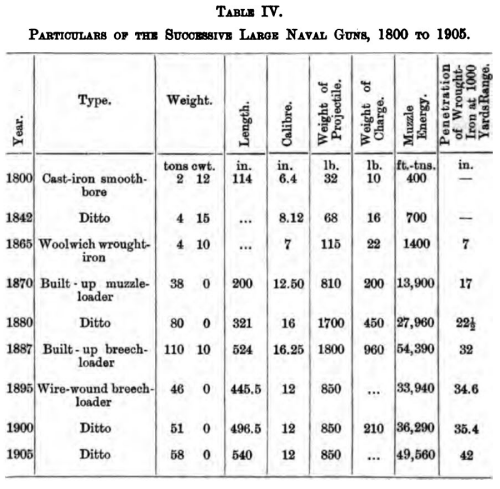
Attention was further directed to the improvement of explosives; and
ultimately, instead of gunpowder having a potential energy of 480
foot-tons per pound, modified gun-cotton was introduced, with an energy of
716 foot-tons per pound, and still later there were evolved explosive
compounds of which the potential energy per unit of weight was fourfold
greater than in the case of gunpowder, namely, 1139 foot-tons per pound.
Finally, the explosive has taken the form of cordite, which ensures slow
burning, great expansion, and, consequently, augmented propelling power
behind the projectile, without material addition to the maximum strain
upon the weapon. But in any case the constructional strength of the modern
gun is enormously superior to the earlier built-up weapons, as around the
inner tubes there is coiled something like 120 miles of wire, which itself
has a breaking-strain of between 90 and 110 tons per square inch, and is
put on under a tension of from 54 tons per square inch on the inner wires
to 32 tons per square inch on the outer wires,' so that the ultimate
resistance to strain consequent upon the firing of the gun is enormously
increased. Velocities of 2600 ft. per second are thus realised, and even
more is quite feasible, so that penetration of wrought iron at 1000 yards
range has now been increased to 42 in.
If we compare the 12-in, gun to-day with the weapon of the same calibre of
twenty years ago, when there was no widened chamber for the explosive,
when prismatic powder of low expansive power was used, it is found, as
shown in the Table opposite, that the penetration at 1000 yards has been
doubled, and the possible effective range multiplied fivefold. There has
also been an enormous gain in quicker fire by improved breech mechanism
and efficient hydraulic and electric mountings, whereby the gun and all
its loading, elevating, and training machinery is rotated.
The metallurgist has also been successfully occupied, and it is probable
that the armour plate of to-day is still invulnerable. The earlier
wrought-iron plates were increased from 41 in. in thickness on the Warrior
of 1861, to the 24 in. on the Inflexible of 1881; the area protected being
almost proportionately reduced. The artillerist with improved projectiles
ultimately defeated this heavy cleading on the ships; but compound armour,
first made in 1879, enabled the maximum thickness on the broadside to be
reduced to 18 in., permitting a greater area to be covered for the same
weight. At first the 80-ton gun failed in its attack, but heavier weapons,
with improved projectiles, prevailed. The next step was the introduction
of all-steel armour in 1890. Two years later there was introduced the
super-carburising and subsequent chilling of the face of plates made of an
alloy of nickel steel. In 1897 the process of hardening was still further
developed, and now the 9-in, plate on the modern battleship is equal in
resistance to a 26-in, wrought-iron plate of the 'sixties, or a 20-in.
compound-plate of the 'eighties, or a 13-in. plate of the early-hardened
type. For the present, therefore, the armour seems to have secured the
victory, as at 5000 yards range 9-in, armour can scarcely be defeated by
even the 12-in. gun.
With the increased resistance of armour and the consequent reduction in
its thickness, the naval designer can spread his protecting plates over a
much wider area, so that the whole broadside of ships like the Prince of
Wales, or the cruisers Argyll and Defence, is clad with armour of
satisfactory resisting power. At the same time the gun-power and speed of
ships have been greatly increased without making the displacement
inordinately high. On the opposite page a Table gives the main features of
representative ships at different epochs, which will show this at a
glance.
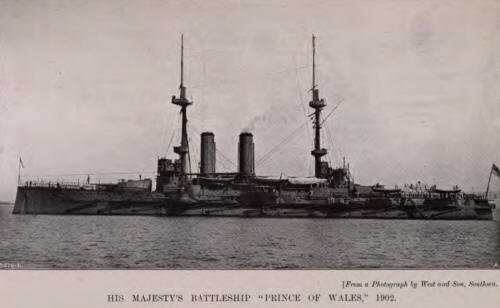
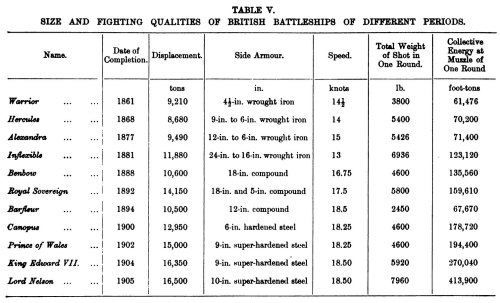
The growth in the size of battleships has been steady, with the exception
of the class represented by the Barfleur and Canopus, both of which were
engined by the Scotts. These vessels are embodiments of a desire to check
the advance in the size and cost of the battleship. The deficiency in the
number and calibre of their guns was partly compensated by the
introduction, for the first time in battleships, of quick-firing weapons
of large calibre. The Barfleur had four 12 in. breechloaders and ten 4.7
in. quick-firers; while the Canopus had four 10 in. breechloaders and ten
6 in. quick-firers. But opinion has again strongly grown in favour of
having in each British ship the best that can be achieved; and thus the
Prince of Wales has a displacement greater than any previous ship, while
in the King Edward and the Lord Nelson classes there has been a further
growth in every element of power. The probabilities, too, are that we have
not yet by any means seen the end of this advance.
As to the machinery made by the Scotts for these battleships, the Barfleur
had three-cylinder, triple-expansion twin-screw engines, to run at 108
revolutions, and to develop 13,000 indicated horse-power. On her trials
the power was 13,163 indicated horse-power. There are eight single-ended,
return-tube, cylindrical boilers, working at 155 lb. pressure. Other
details are given in the Table on page 53.
The engines of the Canopus are illustrated on page 49 by a drawing taken
from a Paper read at the Institution of Civil Engineers, by Sir John
Durston and Admiral H. J. Oram.1 This was the first type of British
battleship fitted with water-tube boilers. She was followed soon after by
the Prince of Wales.
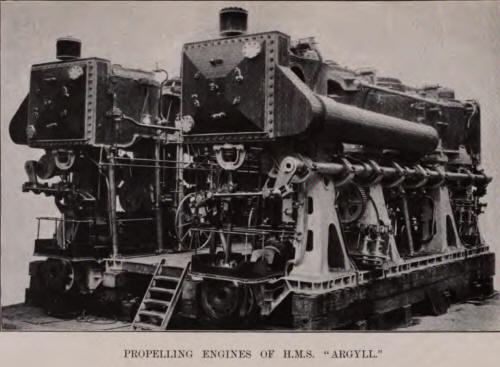
The Argyll, which was built and engined by the Scotts, and the Defence,
which is being built in one of the Royal Dockyards, and is having its
machinery constructed by the Scotts, signalise progress in cruiser design.
The hardening of armour, increasing its resistance, permits of a reduction
in weight for a given measure of protection, so that it has been possible
to effectively defend the modern cruiser, while at the same time giving an
enormously increased gun- power and a speed far in excess of that possible
ten years ago. The Argyll is a vessel of 10,850 tons displacement, being
450 ft. long, 68 ft. 6 in. beam, and having a draught of 25 ft.; while the
Defence is a vessel of 14,600 tons displacement, having a length of 490
ft., a beam of 74 ft. 6 in., and a draught of 26 ft. In both ships the
greater part of the broadside, from 5 ft. below the water-line to the
upper deck, is armoured, and a very large proportion of the area thus clad
has 6-in, hardened plates.
In the late 'nineties it was assumed that quick-firing artillery was best
suited to the work of a cruiser, and thus the 6-in, gun was exclusively
adopted. But since then Naval strategists have developed their ideas as to
the function of armoured cruisers, and now anticipate their use in the
line of battle; so that not only has the defensive quality been improved,
but the offensive power has been materially increased. In the Defence, and
the other ships of the class, the 6-in, gun has been entirely discarded in
favour of an installation of 9.2-in, and 7.5-in. weapons. Owing to the
perfection of the hydraulic and electric mountings, little has been
forfeited in respect of rapidity of fire, while much has been gained in
the striking energy at a given range of each projectile. Thus, while the
6-in, gun five years ago had an energy equal to penetrating 6 in. of
wrought iron at 3000 yards' range, the 7.5-in, weapon now may perforate 61
in., and the 9.2-in. gun 9 in. of the hardest armour at corresponding
range. The total weight of projectiles fired from the present-day cruiser
in a minute is double, and the muzzle energy quadruple, the results
attained by the cruisers designed at the close of the nineteenth century.
The modern cruisers steam at 23 knots, the power of the machinery in the
Argyll being 21,000 indicated horsepower, and in the Defence 27,000
indicated horse-power. The machinery of the Argyll, which is typical,
consists of four sets of triple-expansion engines, arranged in separate
watertight compartments. The diameters of the cylinders are:
high-pressure, 44 in.; intermediate-pressure, 65- in.; and the two
low-pressure, each 73k- in., all having a stroke of 42 in. At full power,
developed with 138 revolutions, the piston speed is 966 ft. per minute.
The cylinders are fitted with liners, and are steam-jacketed; forged steel
is used for the liners of the high- and intermediate-pressure cylinders,
and cast-iron for those of the low-pressure cylinders. The cylinder covers
and pistons are of cast steel, the latter being of conical form. The high-
and intermediate-pressure cylinders have piston valves, and the
low-pressure cylinders flat valves. The cylinders are supported at the
front by eight forged-steel columns, and at the rear by four cast-iron
columns formed with guide-faces, and one forged steel column. The
crankshaft is in four pieces, the high- and intermediate-pressure parts
being interchangeable with each other, and the two low-pressure parts with
one another. The shafts are hollow, and three - bladed propellers of
manganese bronze are fitted to each.. The condensers are entirely
separate, and independent air pumps are fitted.
The Argyll had a combination of six cylindrical and sixteen water-tube
boilers, but in the later ships, including the Defence, the boilers are
entirely of the water-tube type. The working pressure of the boiler is 275
lb., reduced at the engines to 250 lb. The trials of the Argyll were
carried through most satisfactorily, and the vessel, under the new
Admiralty conditions, was completed for commission by the builders. The
fact that this armoured cruiser was so completed at the builder's yard is
of itself evidence of the capacity and efficiency of the plant.
|

